child seat VOLVO V90 2017 Owners Manual
[x] Cancel search | Manufacturer: VOLVO, Model Year: 2017, Model line: V90, Model: VOLVO V90 2017Pages: 594, PDF Size: 15.07 MB
Page 4 of 594
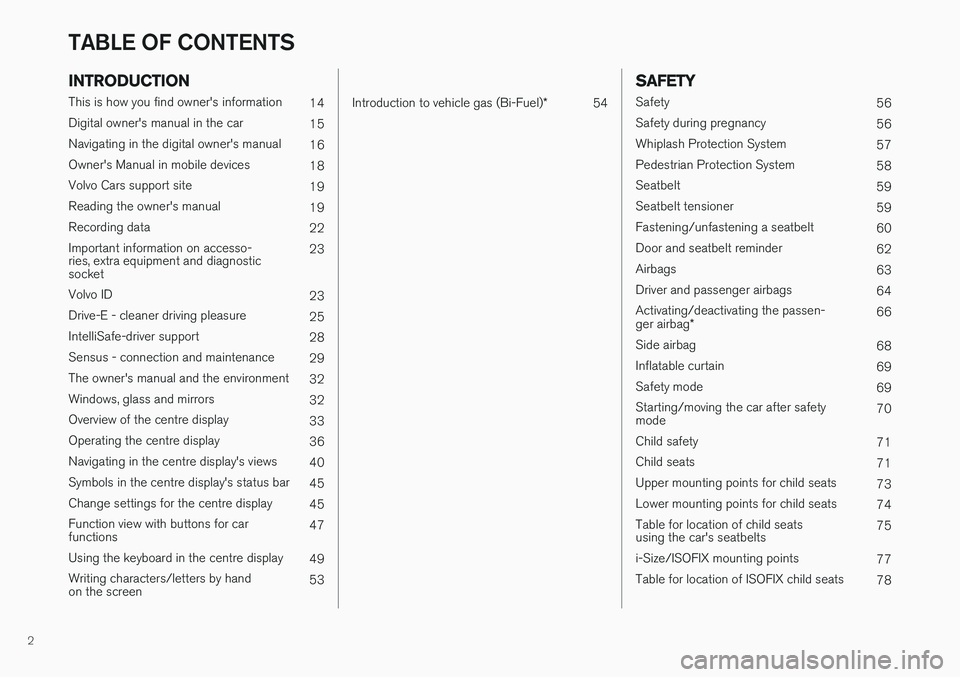
2
INTRODUCTION
This is how you find owner's information14
Digital owner's manual in the car 15
Navigating in the digital owner's manual 16
Owner's Manual in mobile devices 18
Volvo Cars support site 19
Reading the owner's manual 19
Recording data 22
Important information on accesso- ries, extra equipment and diagnosticsocket 23
Volvo ID 23
Drive-E - cleaner driving pleasure 25
IntelliSafe-driver support 28
Sensus - connection and maintenance 29
The owner's manual and the environment 32
Windows, glass and mirrors 32
Overview of the centre display 33
Operating the centre display 36
Navigating in the centre display's views 40
Symbols in the centre display's status bar 45
Change settings for the centre display 45
Function view with buttons for carfunctions 47
Using the keyboard in the centre display 49
Writing characters/letters by handon the screen 53
Introduction to vehicle gas (Bi-Fuel)
*
54
SAFETY
Safety
56
Safety during pregnancy 56
Whiplash Protection System 57
Pedestrian Protection System 58
Seatbelt 59
Seatbelt tensioner 59
Fastening/unfastening a seatbelt 60
Door and seatbelt reminder 62
Airbags 63
Driver and passenger airbags 64
Activating/deactivating the passen- ger airbag * 66
Side airbag 68
Inflatable curtain 69
Safety mode 69
Starting/moving the car after safety mode 70
Child safety 71
Child seats 71
Upper mounting points for child seats 73
Lower mounting points for child seats 74
Table for location of child seatsusing the car's seatbelts 75
i-Size/ISOFIX mounting points 77
Table for location of ISOFIX child seats 78
TABLE OF CONTENTS
Page 5 of 594
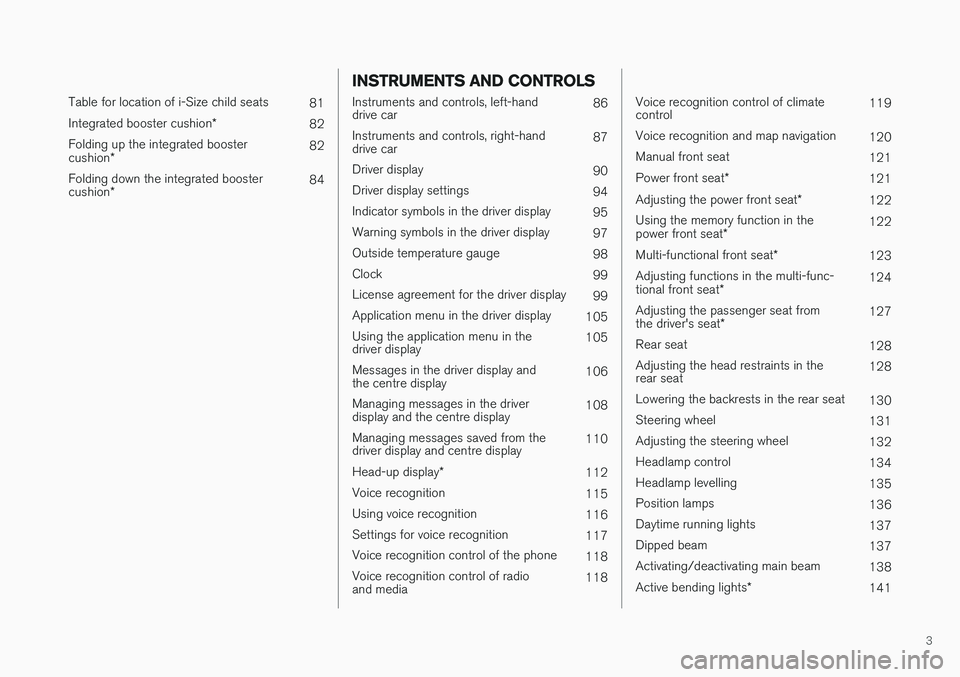
3
Table for location of i-Size child seats81
Integrated booster cushion *
82
Folding up the integrated booster cushion * 82
Folding down the integrated boostercushion * 84
INSTRUMENTS AND CONTROLS
Instruments and controls, left-hand drive car
86
Instruments and controls, right-handdrive car 87
Driver display 90
Driver display settings 94
Indicator symbols in the driver display 95
Warning symbols in the driver display 97
Outside temperature gauge 98
Clock 99
License agreement for the driver display 99
Application menu in the driver display 105
Using the application menu in thedriver display 105
Messages in the driver display andthe centre display 106
Managing messages in the driverdisplay and the centre display 108
Managing messages saved from thedriver display and centre display 110
Head-up display *
112
Voice recognition 115
Using voice recognition 116
Settings for voice recognition 117
Voice recognition control of the phone 118
Voice recognition control of radioand media 118
Voice recognition control of climate control119
Voice recognition and map navigation 120
Manual front seat 121
Power front seat *
121
Adjusting the power front seat *
122
Using the memory function in the power front seat * 122
Multi-functional front seat *
123
Adjusting functions in the multi-func-tional front seat * 124
Adjusting the passenger seat fromthe driver's seat * 127
Rear seat 128
Adjusting the head restraints in the rear seat 128
Lowering the backrests in the rear seat 130
Steering wheel 131
Adjusting the steering wheel 132
Headlamp control 134
Headlamp levelling 135
Position lamps 136
Daytime running lights 137
Dipped beam 137
Activating/deactivating main beam 138
Active bending lights *
141
Page 7 of 594
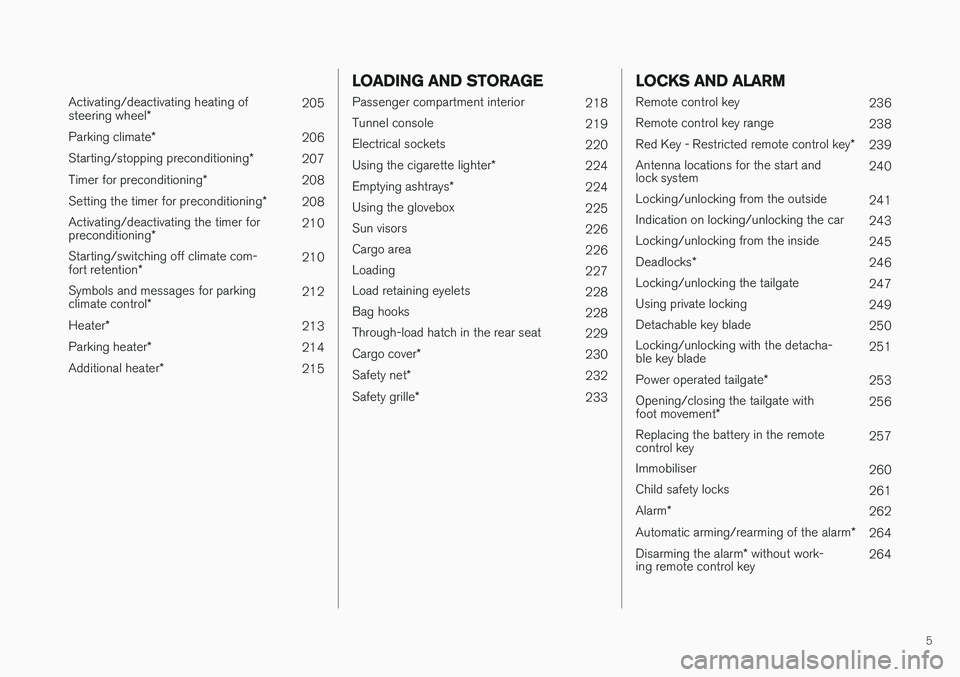
5
Activating/deactivating heating of steering wheel* 205
Parking climate *
206
Starting/stopping preconditioning *
207
Timer for preconditioning *
208
Setting the timer for preconditioning *
208
Activating/deactivating the timer forpreconditioning * 210
Starting/switching off climate com-fort retention * 210
Symbols and messages for parkingclimate control * 212
Heater *
213
Parking heater *
214
Additional heater *
215
LOADING AND STORAGE
Passenger compartment interior
218
Tunnel console 219
Electrical sockets 220
Using the cigarette lighter *
224
Emptying ashtrays *
224
Using the glovebox 225
Sun visors 226
Cargo area 226
Loading 227
Load retaining eyelets 228
Bag hooks 228
Through-load hatch in the rear seat 229
Cargo cover *
230
Safety net *
232
Safety grille *
233
LOCKS AND ALARM
Remote control key
236
Remote control key range 238
Red Key - Restricted remote control key *
239
Antenna locations for the start and lock system 240
Locking/unlocking from the outside 241
Indication on locking/unlocking the car 243
Locking/unlocking from the inside 245
Deadlocks *
246
Locking/unlocking the tailgate 247
Using private locking 249
Detachable key blade 250
Locking/unlocking with the detacha-ble key blade 251
Power operated tailgate *
253
Opening/closing the tailgate with foot movement * 256
Replacing the battery in the remote control key 257
Immobiliser 260
Child safety locks 261
Alarm *
262
Automatic arming/rearming of the alarm *
264
Disarming the alarm * without work-
ing remote control key 264
Page 58 of 594
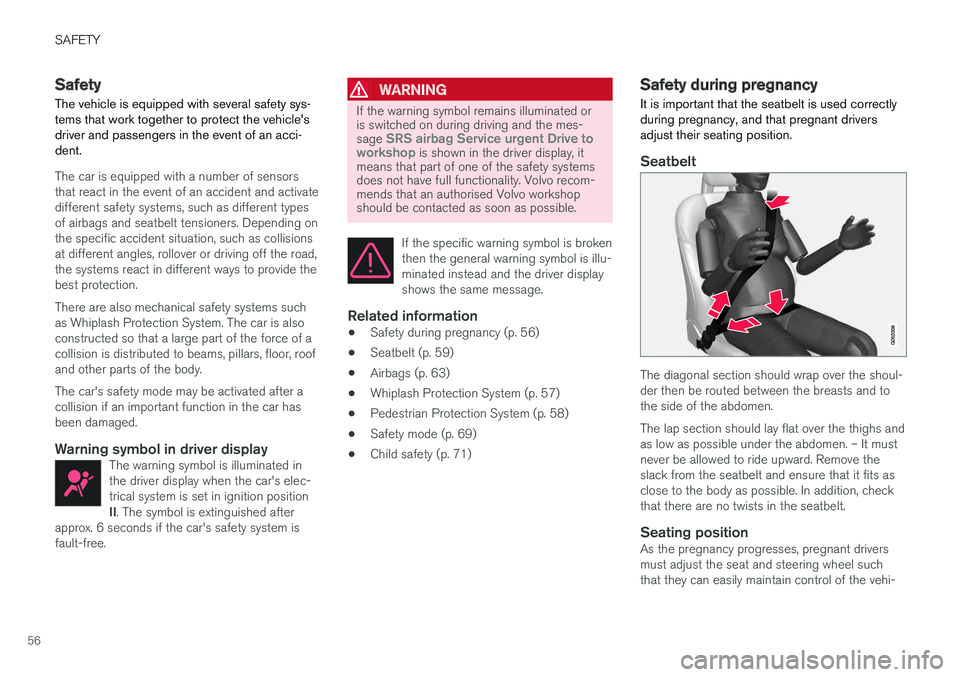
SAFETY
56
Safety
The vehicle is equipped with several safety sys- tems that work together to protect the vehicle'sdriver and passengers in the event of an acci-dent.
The car is equipped with a number of sensors that react in the event of an accident and activatedifferent safety systems, such as different typesof airbags and seatbelt tensioners. Depending onthe specific accident situation, such as collisionsat different angles, rollover or driving off the road,the systems react in different ways to provide thebest protection. There are also mechanical safety systems such as Whiplash Protection System. The car is alsoconstructed so that a large part of the force of acollision is distributed to beams, pillars, floor, roofand other parts of the body. The car's safety mode may be activated after a collision if an important function in the car hasbeen damaged.
Warning symbol in driver displayThe warning symbol is illuminated inthe driver display when the car's elec-trical system is set in ignition position II . The symbol is extinguished after
approx. 6 seconds if the car's safety system is fault-free.
WARNING
If the warning symbol remains illuminated or is switched on during driving and the mes- sage
SRS airbag Service urgent Drive to
workshop is shown in the driver display, it
means that part of one of the safety systems does not have full functionality. Volvo recom-mends that an authorised Volvo workshopshould be contacted as soon as possible.
If the specific warning symbol is broken then the general warning symbol is illu-minated instead and the driver displayshows the same message.
Related information
•Safety during pregnancy (p. 56)
• Seatbelt (p. 59)
• Airbags (p. 63)
• Whiplash Protection System (p. 57)
• Pedestrian Protection System (p. 58)
• Safety mode (p. 69)
• Child safety (p. 71)
Safety during pregnancy It is important that the seatbelt is used correctly during pregnancy, and that pregnant driversadjust their seating position.
Seatbelt
The diagonal section should wrap over the shoul- der then be routed between the breasts and tothe side of the abdomen. The lap section should lay flat over the thighs and as low as possible under the abdomen. – It mustnever be allowed to ride upward. Remove theslack from the seatbelt and ensure that it fits asclose to the body as possible. In addition, checkthat there are no twists in the seatbelt.
Seating positionAs the pregnancy progresses, pregnant driversmust adjust the seat and steering wheel suchthat they can easily maintain control of the vehi-
Page 60 of 594
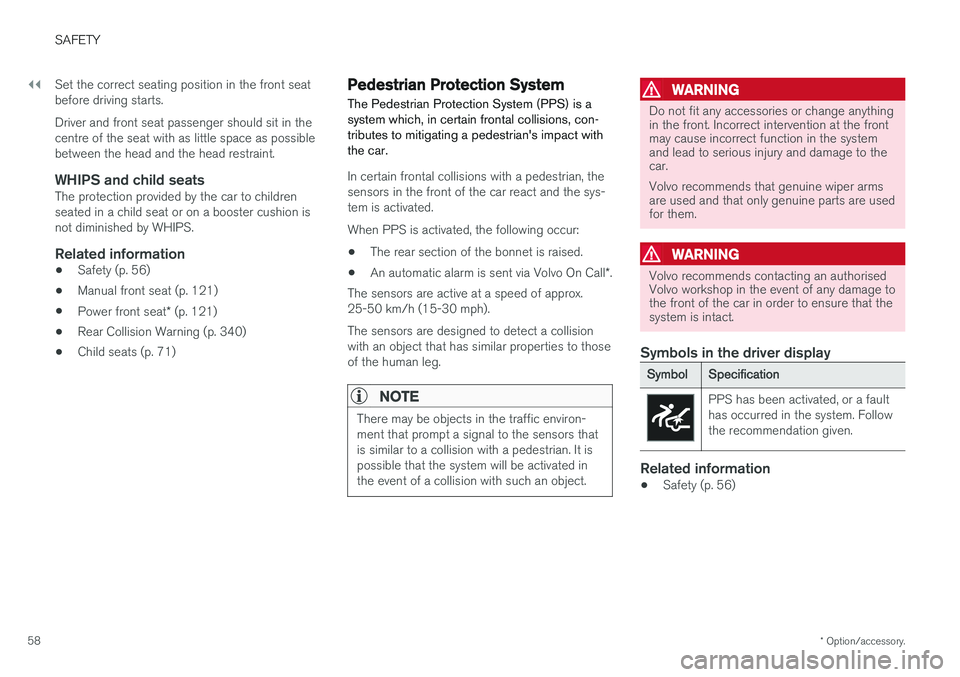
||
SAFETY
* Option/accessory.
58 Set the correct seating position in the front seat before driving starts. Driver and front seat passenger should sit in the centre of the seat with as little space as possiblebetween the head and the head restraint.
WHIPS and child seatsThe protection provided by the car to childrenseated in a child seat or on a booster cushion isnot diminished by WHIPS.
Related information
•
Safety (p. 56)
• Manual front seat (p. 121)
• Power front seat
* (p. 121)
• Rear Collision Warning (p. 340)
• Child seats (p. 71)
Pedestrian Protection System
The Pedestrian Protection System (PPS) is a system which, in certain frontal collisions, con-tributes to mitigating a pedestrian's impact withthe car.
In certain frontal collisions with a pedestrian, the sensors in the front of the car react and the sys-tem is activated. When PPS is activated, the following occur:
• The rear section of the bonnet is raised.
• An automatic alarm is sent via Volvo On Call
*.
The sensors are active at a speed of approx. 25-50 km/h (15-30 mph). The sensors are designed to detect a collision with an object that has similar properties to thoseof the human leg.
NOTE
There may be objects in the traffic environ- ment that prompt a signal to the sensors thatis similar to a collision with a pedestrian. It ispossible that the system will be activated inthe event of a collision with such an object.
WARNING
Do not fit any accessories or change anything in the front. Incorrect intervention at the frontmay cause incorrect function in the systemand lead to serious injury and damage to thecar. Volvo recommends that genuine wiper arms are used and that only genuine parts are usedfor them.
WARNING
Volvo recommends contacting an authorised Volvo workshop in the event of any damage tothe front of the car in order to ensure that thesystem is intact.
Symbols in the driver display
Symbol Specification
PPS has been activated, or a fault has occurred in the system. Followthe recommendation given.
Related information
•Safety (p. 56)
Page 64 of 594
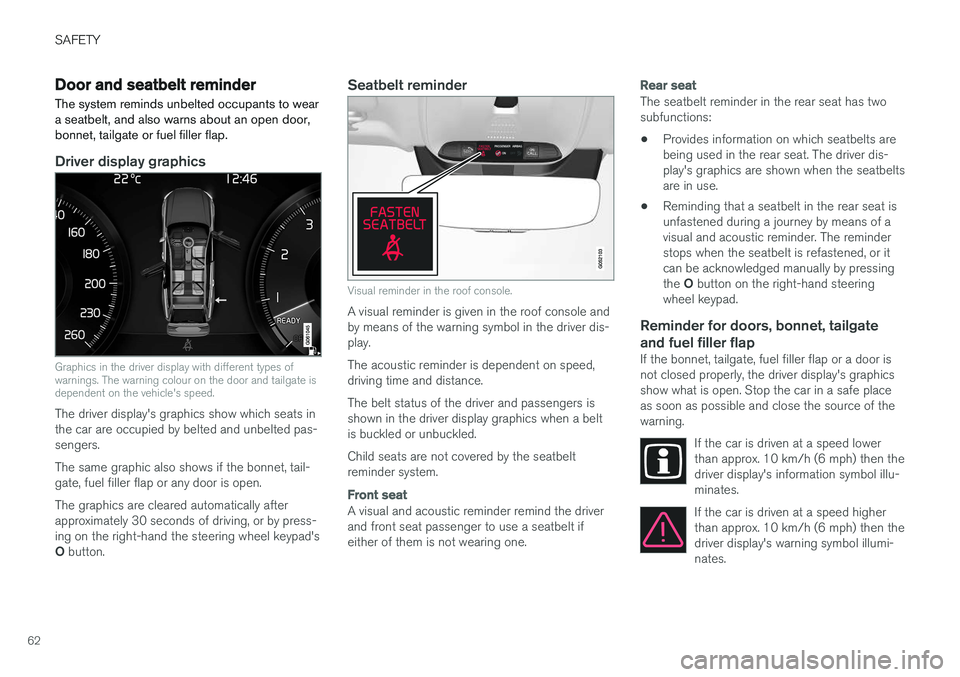
SAFETY
62
Door and seatbelt reminderThe system reminds unbelted occupants to wear a seatbelt, and also warns about an open door,bonnet, tailgate or fuel filler flap.
Driver display graphics
Graphics in the driver display with different types of warnings. The warning colour on the door and tailgate isdependent on the vehicle's speed.
The driver display's graphics show which seats in the car are occupied by belted and unbelted pas-sengers. The same graphic also shows if the bonnet, tail- gate, fuel filler flap or any door is open. The graphics are cleared automatically after approximately 30 seconds of driving, or by press-ing on the right-hand the steering wheel keypad's O button.
Seatbelt reminder
Visual reminder in the roof console.
A visual reminder is given in the roof console and by means of the warning symbol in the driver dis-play. The acoustic reminder is dependent on speed, driving time and distance. The belt status of the driver and passengers is shown in the driver display graphics when a beltis buckled or unbuckled. Child seats are not covered by the seatbelt reminder system.
Front seat
A visual and acoustic reminder remind the driver and front seat passenger to use a seatbelt ifeither of them is not wearing one.
Rear seat
The seatbelt reminder in the rear seat has two subfunctions: • Provides information on which seatbelts are being used in the rear seat. The driver dis-play's graphics are shown when the seatbeltsare in use.
• Reminding that a seatbelt in the rear seat isunfastened during a journey by means of avisual and acoustic reminder. The reminderstops when the seatbelt is refastened, or itcan be acknowledged manually by pressing the
O button on the right-hand steering
wheel keypad.
Reminder for doors, bonnet, tailgate
and fuel filler flap
If the bonnet, tailgate, fuel filler flap or a door is not closed properly, the driver display's graphicsshow what is open. Stop the car in a safe placeas soon as possible and close the source of thewarning.
If the car is driven at a speed lowerthan approx. 10 km/h (6 mph) then thedriver display's information symbol illu-minates.
If the car is driven at a speed higher than approx. 10 km/h (6 mph) then thedriver display's warning symbol illumi-nates.
Page 67 of 594
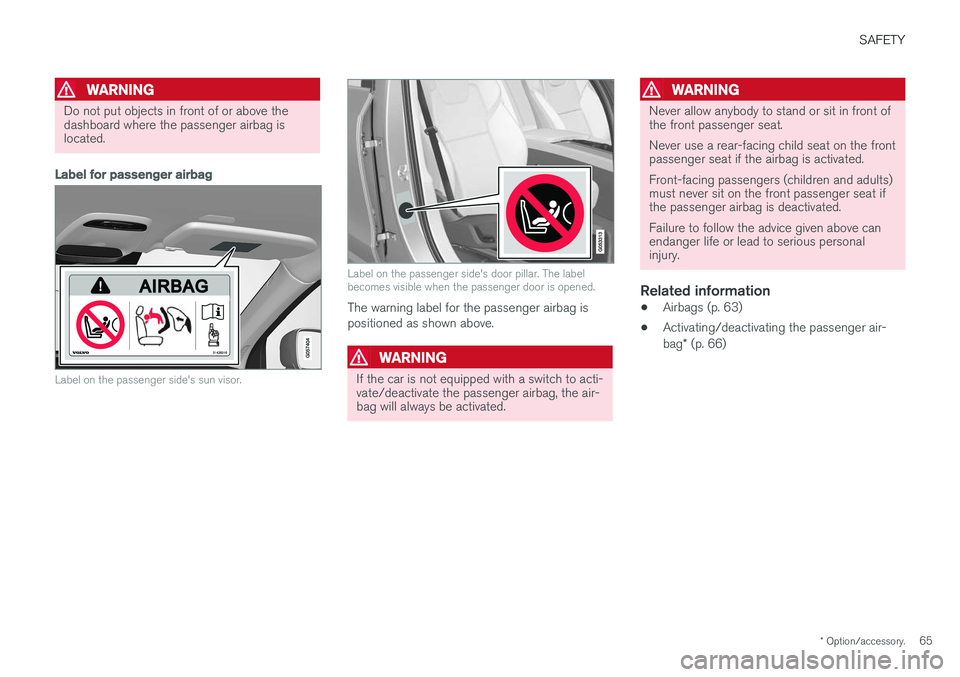
SAFETY
* Option/accessory.65
WARNING
Do not put objects in front of or above the dashboard where the passenger airbag islocated.
Label for passenger airbag
Label on the passenger side's sun visor.
Label on the passenger side's door pillar. The label becomes visible when the passenger door is opened.
The warning label for the passenger airbag is positioned as shown above.
WARNING
If the car is not equipped with a switch to acti- vate/deactivate the passenger airbag, the air-bag will always be activated.
WARNING
Never allow anybody to stand or sit in front of the front passenger seat. Never use a rear-facing child seat on the front passenger seat if the airbag is activated. Front-facing passengers (children and adults) must never sit on the front passenger seat ifthe passenger airbag is deactivated. Failure to follow the advice given above can endanger life or lead to serious personalinjury.
Related information
•Airbags (p. 63)
• Activating/deactivating the passenger air- bag
* (p. 66)
Page 68 of 594
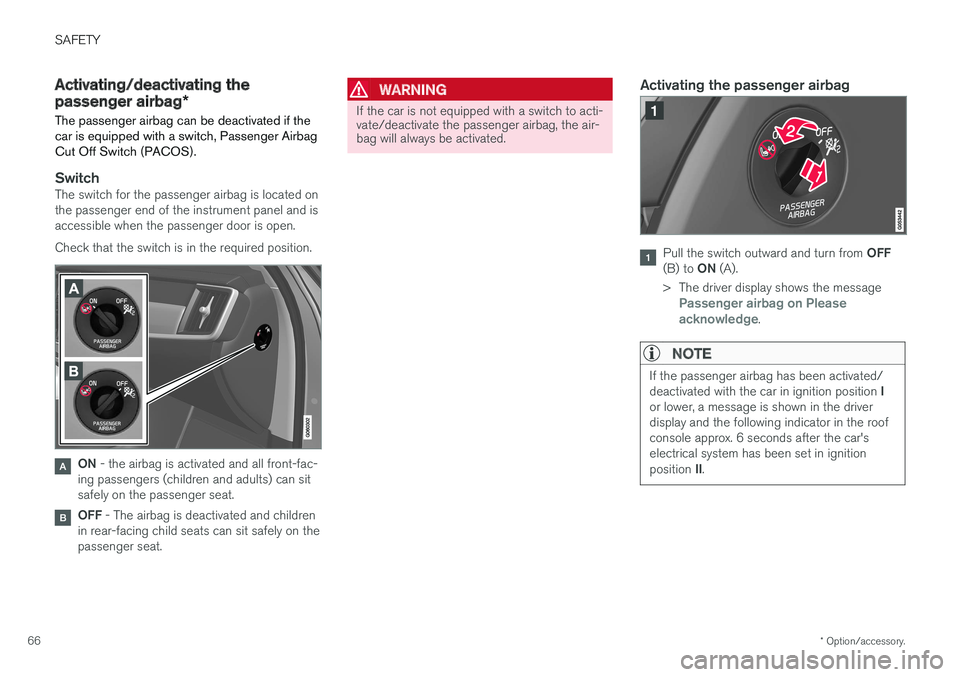
SAFETY
* Option/accessory.
66
Activating/deactivating the passenger airbag *
The passenger airbag can be deactivated if the car is equipped with a switch, Passenger AirbagCut Off Switch (PACOS).
SwitchThe switch for the passenger airbag is located on the passenger end of the instrument panel and isaccessible when the passenger door is open. Check that the switch is in the required position.
ON - the airbag is activated and all front-fac-
ing passengers (children and adults) can sit safely on the passenger seat.
OFF - The airbag is deactivated and children
in rear-facing child seats can sit safely on the passenger seat.
WARNING
If the car is not equipped with a switch to acti- vate/deactivate the passenger airbag, the air-bag will always be activated.
Activating the passenger airbag
Pull the switch outward and turn from OFF
(B) to ON (A).
> The driver display shows the message
Passenger airbag on Please
acknowledge.
NOTE
If the passenger airbag has been activated/ deactivated with the car in ignition position I
or lower, a message is shown in the driver display and the following indicator in the roofconsole approx. 6 seconds after the car'selectrical system has been set in ignition position II.
Page 69 of 594
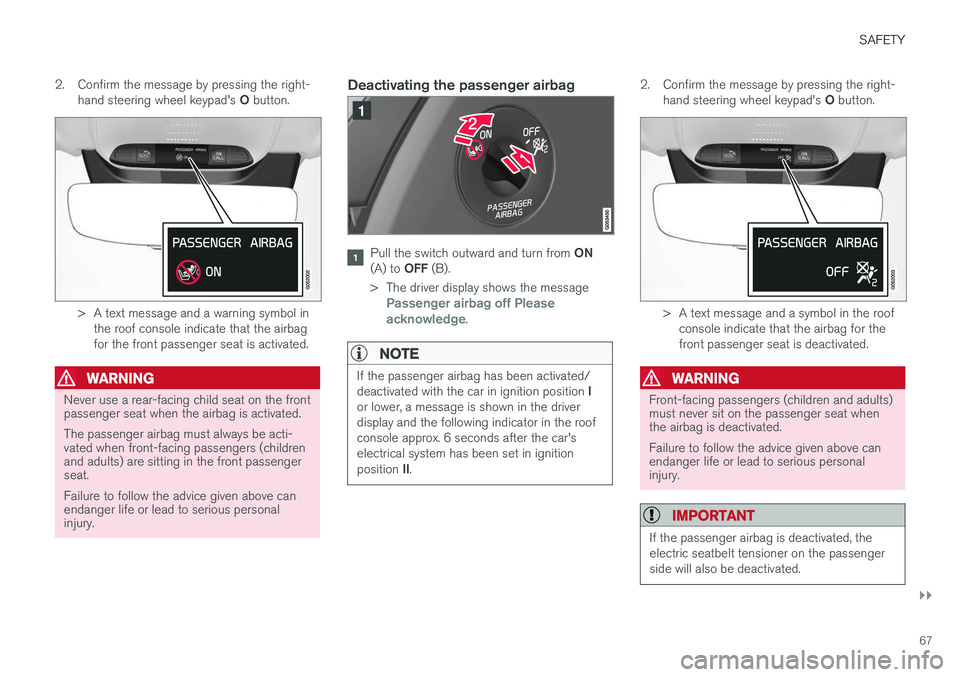
SAFETY
}}
67
2. Confirm the message by pressing the right-
hand steering wheel keypad's O button.
> A text message and a warning symbol in
the roof console indicate that the airbag for the front passenger seat is activated.
WARNING
Never use a rear-facing child seat on the front passenger seat when the airbag is activated. The passenger airbag must always be acti- vated when front-facing passengers (childrenand adults) are sitting in the front passengerseat. Failure to follow the advice given above can endanger life or lead to serious personalinjury.
Deactivating the passenger airbag
Pull the switch outward and turn from ON
(A) to OFF (B).
> The driver display shows the message
Passenger airbag off Please
acknowledge.
NOTE
If the passenger airbag has been activated/ deactivated with the car in ignition position I
or lower, a message is shown in the driver display and the following indicator in the roofconsole approx. 6 seconds after the car'selectrical system has been set in ignition position II.
2. Confirm the message by pressing the right-
hand steering wheel keypad's O button.
> A text message and a symbol in the roof
console indicate that the airbag for the front passenger seat is deactivated.
WARNING
Front-facing passengers (children and adults) must never sit on the passenger seat whenthe airbag is deactivated. Failure to follow the advice given above can endanger life or lead to serious personalinjury.
IMPORTANT
If the passenger airbag is deactivated, the electric seatbelt tensioner on the passengerside will also be deactivated.
Page 70 of 594
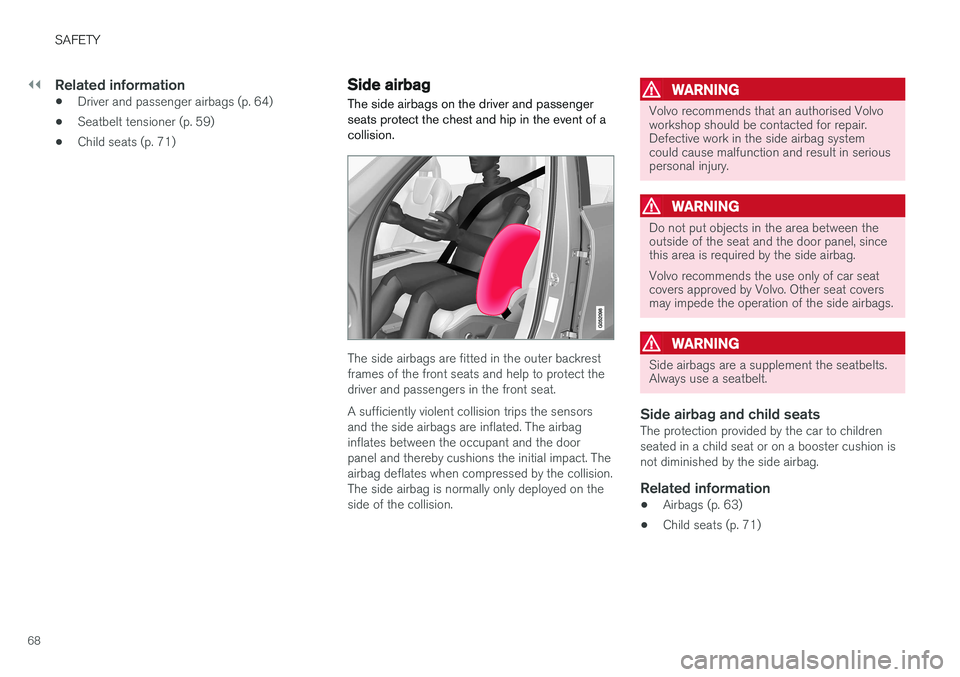
||
SAFETY
68
Related information
•Driver and passenger airbags (p. 64)
• Seatbelt tensioner (p. 59)
• Child seats (p. 71)
Side airbag
The side airbags on the driver and passenger seats protect the chest and hip in the event of acollision.
The side airbags are fitted in the outer backrest frames of the front seats and help to protect thedriver and passengers in the front seat. A sufficiently violent collision trips the sensors and the side airbags are inflated. The airbaginflates between the occupant and the doorpanel and thereby cushions the initial impact. Theairbag deflates when compressed by the collision.The side airbag is normally only deployed on theside of the collision.
WARNING
Volvo recommends that an authorised Volvo workshop should be contacted for repair.Defective work in the side airbag systemcould cause malfunction and result in seriouspersonal injury.
WARNING
Do not put objects in the area between the outside of the seat and the door panel, sincethis area is required by the side airbag. Volvo recommends the use only of car seat covers approved by Volvo. Other seat coversmay impede the operation of the side airbags.
WARNING
Side airbags are a supplement the seatbelts. Always use a seatbelt.
Side airbag and child seatsThe protection provided by the car to children seated in a child seat or on a booster cushion isnot diminished by the side airbag.
Related information
• Airbags (p. 63)
• Child seats (p. 71)